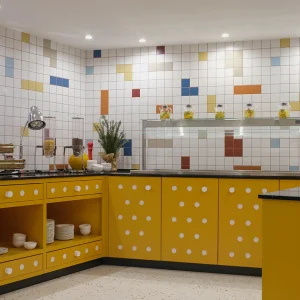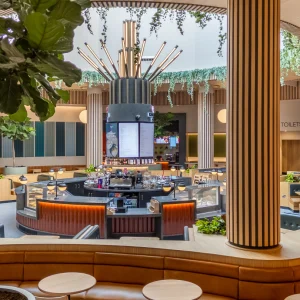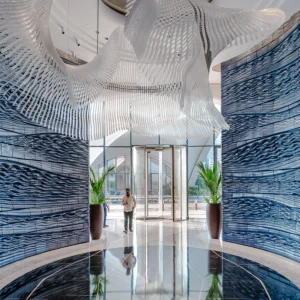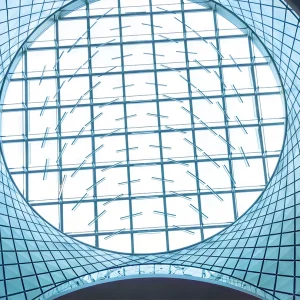
It’s September 2013, and London’s lovers of arts and bars will be wishing a fond farewell to some of the most dynamic and well-used spaces of the summer. From Sou Fujimoto’s sublime Serpentine Gallery Pavilion in Hyde Park – once a seasonal exercise in contemporary architecture PR and now a well-loved annual institution – to the possibly ridiculous but nevertheless wonderful Frank’s Bar and sculpture park sited on top of a neglected Seventies’ car park in Peckham, which has been gathering ever greater numbers of local, national and international visitors since it first opened in 2009.
Pairing an annual sculpture exhibition, Bold Tendencies – a commissioning vehicle for contemporary sculpture conceived by young gallerist Hannah Barry – with a striking and makeshift bar venue was a clever move that helped shoot Barry into the firmament of young art-world stars.
But the grotty grandeur of the car park itself is what gives it a whiff of genius. I’m proud to say I was an early adopter and, as a long-time Peckham resident, there was and is still something glorious about seeing the art world’s glitterati picking their way through the debris of Peckham High Street – past the discarded McDonald’s wrappers and the open-fronted butcher’s shops selling bags of unrecognisable ‘chicken pieces’ for 50p – to check the venue out; venturing nervously into the urine and bleach-soaked staircase to be mugged only by the panoramic views over Southwark and the Thames riverfront, lit up at dusk like a string of architectural fairylights. Open July to September.
Each year, its arrival has become an eagerly anticipated part of an ever-more interesting local foodie and arts-rich scene.
Frank’s Bar and Bold Tendencies are just part of a flowering of temporary place-making that has undoubtedly been given extra momentum by the era of austerity – who cares if a bar has been thrown together with scaffolding planks or a theatre constructed from cheap wooden pallets, as long as the offer is good. When nobody can afford to party in Park Lane, a car park or a shipping container strikes just the right tone for spontaneous fun for the cash-strapped. To paraphrase Homer Simpson: ‘When shit hits the fan, make fertiliser.’

Of course architects are well versed in throwing up beautifully executed temporary pavilions for college projects and – if they’re lucky – paid commissions – but this is something more. These are structures that somehow bring focus to an event or a community; if they’re done right, they nurture an ongoing dialogue with the site, galvanising and gathering new communities of interest. And the grittier the venue, the more visitors appear to delight in finding a gem at its heart.
Morag Myerscough is something of a veteran at low-budget place-making in both permanent and temporary locations. She first experimented with temporary structures back in 1993, when AHMM asked her to liven up some hoardings around a British Land construction site. She says: ‘Then the councils wanted to pull it down because it was too colourful. In those days there weren’t the opportunities there are now – people who had to give permission wouldn’t let you. Now they have seen the benefits of livening up dead space to engage the community.’
Myerscough has since deployed her skills in many a blighted spot: for example, bringing colour and street life to the pavement in front of the London College of Communication’s grimy tower block, as well as creating dynamic community cafes and consultation vehicles on empty building sites, first in Deptford (2008), then Greenwich (2012), and now Hayes for developer Cathedral Group (see case study).
We’ll venture into all manner of forbidding-looking places for a decent cup of coffee, it seems. But you have to get the design language right: it is all about simplicity, with bold sweeps of colour, playful and unexpected geometries and furnishings, and rough, honest textures. Says Myerscough: ‘I always start from a position of working out…how can a small amount of money completely change people’s ways of thinking about a place and encourage them to come and see it.’
Hannah Barry admits the original inspiration for Frank’s Bar came from the question ‘How do we make people feel they might stay longer in a place they find quite hostile? Give them a cup of tea and a piece of cake.’
Well, chefs and bar owners Frank and Mike Boxer gave them more than that, but nobody would have come to check out their offer if it hadn’t been for the inspired piece of low-tech architecture cooked up by architects Paloma Gormley and Lettice Drake: Frank’s Bar comprises little more than a collection of scaffolding boards, ratchet straps and a giant piece of red pvc. It suits the rough-and-ready nature of the surrounding concrete.
Taking people out of their comfort zones is part of Barry’s mission, she says: ‘Works of art are supposed to make you think differently about yourself and make you think in a new way.’ For her, the car-park setting was also a way of declaring ‘This project is for everyone. It’s not just for the cognoscenti of the art world.’
It also minimised the risk for the Boxer brothers, who have gone on to become stars in their own right opening a highly successful new restaurant last year, The Brunswick Café, within salvage supremo Lassco’s listed Mansion by Vauxhall Bridge. Here rare lamb, cannelloni beans and chianti are served up alongside Lassco’s reclaimed chandeliers, church pews and armoires, all with price tags dangling.
There is something about a low-risk, low-budget, temporary venture that seems to boost creativity – necessity, after all, being the mother of invention. Softroom director Christopher Bagot says: ‘In the world of food, one of the reasons why this is so successful is that operators who can’t get a long lease or big investment do something small and experimental. Some pop-ups just allow foodie restaurateurs to find an outlet that might lead to them getting a permanent venue.’
Bagot’s first temporary site was a little different: it was a means of grabbing a short-term, high-profile location for established Mexican street food chain Wahaca, with which Softroom has developed a close relationship since it put the brand on the map in 2006, transforming a dingy, airless basement in Covent Garden into a destination eaterie. Wahaca’s first temporary venue came about in 2012 when a site on the South Bank, next to the Queen Elizabeth Hall, came up. Tucked between the QEH and Waterloo Bridge, it had been occupied by a demountable hut, used first as an overspill office and then as Asian street food venue, Dishoom Chowpatty Bar.
Bagot says: ‘It’s an amazing site now. But for the past 20 years it was seen as one of the worst, before the South Bank became so fully inhabited.’ As Bagot and Wahaca director Mike Selby scoped out the QEH terrace, the idea emerged of using shipping containers – Bagot could see that in the current single-storey site you could fit two containers, and with a cluster of them arranged in the right way, create a memorable and distinctive but highly cost-effective venue.
There were constraints, he says: ‘The container dimensions are 8ft x 8ft x 40ft. That’s not ideal. And also, structurally, you have work to do because they’re covered in metal cladding, and we wanted to have windows. They are not the most obvious choice. Because it’s not a pop-up, it means it had to be built to last several winters. So, effectively, that does mean you are creating a building (summer pop-ups don’t need heating or ventilation). And with the terrace added, you are serving up to 280 people at a time, so you need big kitchens and storage. What’s more, it was a temporary life span but it still cost a fair amount of money. One of the ways you justify it is to give the building a life beyond this site – even if we are only on the South Bank for two years or so, we can pick it up, put it on the back of a lorry and take it somewhere else.’
The South Bank Wahaca, now completing its second summer, has been a great success. But what Bagot has been most delighted by is how it has helped animate the outdoor space around it which, in the past year, has hosted multiple markets, beaches with multicoloured sand, fountains, cloth baobab trees and giant Lego installations.
He says: ‘That outdoor space has got better and better over the years…This is a very special couple of years, when the Southbank Centre has got as good as it has in programming all its wild and random spaces.’ He hopes – as we all do – that this vibrant street life isn’t killed off when the master plan for the South Bank’s whole area kicks in.
But the creativity shows no signs of abating just yet: earlier this year, a few metres on from Wahaca, a big, red, wooden building landed outside the National Theatre. It turned out to be a new temporary theatre space: The Shed is a 250-seater venue designed with great ingenuity by Haworth Tompkins to offer a home for small-scale, experimental and unusual theatre projects usually ruled out by the sheer scale and audience size demanded by the NT’s normal venues. Its purpose was both practical and symbolic. It was initially a stop-gap small theatre for audiences while the Cottesloe (the smallest of the NT’s three theatres) underwent a year’s refurbishment.
Symbolically, it has proved something of a rebirth for this iconic theatre company, allowing it to address a growing audience demand for more experimental, visceral and intimate theatre experiences. Creating and programming The Shed has been something of an ‘out of body experience’ for the company, says Haworth Tompkins associate director Paddy Dillon, in that it has led to a whole series of new and exciting questions about who The Shed is appealing to, and what risks it can take with style and content that would be unthinkable in the NT’s bigger auditoria.
Ben Power, NT associate director affirms this: ‘It’s hugely exciting for the artists coming here. We can give them a space where risk is encouraged. The performer-audience relationship is very different. The very temporary nature of it feels like it releases something. For new artists and others who have worked in the Olivier and Cottesloe, they can come in here and try out something they haven’t done before. It’s about a diversity of work – a whole range of different things The Shed feels like it allows us to do. There’s an energy to the building.’
Haworth Tompkins has a strong track record not just with theatrical and performance spaces (it has extended, refurbished or restored most of the UK’s leading theatres) but also temporary venues, having created two highly acclaimed interim spaces for the Almeida. So what does the temporary building offer both client and designer that anything more permanent doesn’t? Dillon says: ‘It’s more like an event than a building – it can be strange, enigmatic and playful.’
It also prods designers into being more resourceful, creative and experimental. For Haworth Tompkins, The Shed has become an exciting prototype for sustainable temporary structures. Myerscough thinks creating temporary spaces on tight budgets actually helps designers to focus on the essentials: ‘It all goes back to placemaking’, she says. ‘Everybody’s mindset goes a bit weird when it’s permanent. But if it’s temporary and becomes permanent, it starts with a much better attitude.’
The Shed at The National Theatre

Designed and built over a year in conjunction with theatre and design specialist Charcoalblue, The Shed is a temporary 250-seat venue for the National Theatre, while its smaller Cottesloe Theatre is refurbished. Sustainability and quality were the driving factors from the start, says Haworth Tompkins associate director Paddy Dillon: ‘It would have seemed intensely wrong to put in an expensive and high-energy building here.’
The design started with Charcoalblue’s simple solution of a three-sided performance area with a small fixed balcony, internal performer/ audience circulation and the possibility of in-the-round and flat-floor formats, thanks to flexible seating blocks. The four towers emerged from the need to make it naturally ventilated – the four corner chimneys draw air through and around the space via grilles underneath the seating rig.
The Shed is clad in rough pallet timber, echoing the patterning on the board-marked concrete of the main building and keeping costs down and portability up – the structure can be easily dismounted and reassembled elsewhere. The pallet wood also ‘give it that non-architectural feel, more like an object than a building,’ says Dillon. The red colour was initially inspired by Scandinavian agricultural barns. ‘We also thought that, against the grey bulk of the NT a single red object would be very interesting, and slightly surreal,’ says Dillon.
The building’s unfinished steel frame can be reused. All of the seats came out of the Cottesloe, as did most of the lighting rig. The interior is not a ‘black box’: it is lined with stained dark brown plywood panels, whose texture ‘grins through the stain’, says Dillon, creating a warm and crafted atmosphere.
Client: National Theatre
Architecture and interiors: Haworth Tomkins
Cost: £1.2m / Completed: March 2013
Theatre consultant: Charcoalblue
Main contractor: Rise Contracts
Acoustics: Arup Acoustics
The Old Vinyl Factory Canteen

Designer Morag Myerscough was recruited to transform a bland corporate space in the former EMI factory into an appealing and contemporary reception, cafe and community hub for developer Cathedral Group soon after it had acquired the site in Hayes, Middlesex, in 2011. The target customer base is drawn from two distinct audiences: the 500 people still working on the site as well as potential occupants and the architects and construction workers involved in creating what will be a dynamic £250m mixed-use development featuring residential, leisure and commercial premises.

In deploying her modest budget Myerscough has worked according to ‘levels of temporariness’. For example, in the existing reception area, which will be ripped out and redone at some point, she has simply stripped the space back to the essentials, stuck the new name for the building (The Shipping Building) on the wall in giant letterpress word blocks, lowered the previous reception desk, clad it in Corian, and installed a new sofa.
The canteen uses a winning formula of white walls, black chalkboards and black-and-white chequered linoleum, with a big serving counter enhanced by colourful tiling. Added atmosphere comes from a billowing yellow canopy to soften the lofty ceiling height, plus an entire wall decorated with 1,000 7in record sleeves.

‘But the furniture is permanent’, says Myerscough. Designed and made by her Supergroup colleague Luke Morgan, the wooden tops for tables and benches are supplied by the Wood Recycling Project in Brighton (another Cathedral tenant) from reclaimed beams, with additional furniture sourced from eBay.
Client: Cathedral Group
Designers: Morag Myerscough and Luke Morgan
Completed: 2012
Wahaca Southbank Experiment

Softroom’s Wahaca Southbank Experiment ‘washed up’ on the outdoor terrace of the Queen Elizabeth Hall on 4 July last year: an exuberant installation of eight shipping containers. Painted in Mexican-inspired hues, from deep turquoise to straw yellow, they complement Wahaca’s Mexican street-food fare as strikingly as they contrast with the concrete brutalism of their immediate neighbours. The containers’ 8ft x 8ft x 40ft dimensions have been cleverly deployed to create a two-storey venue that offers equally dramatic vistas inside and out.

The top-floor containers are cantilevered out over the lower floor’s ramped entrance to form a canopy. High-performance insulation ensures warmth in winter, while huge, well-sealed double-glazed sliding doors along the lower and upper fascias maximise views of the Thames. The front and back units are connected via a glazed link, housing a stairway up to the first floor and throwing light on the surrounding dining spaces. A roof terrace and raised timber decking around the building provide additional fair-weather seating space, bringing the total covers up to 280 (indoor seats accommodate up to 130).
The design is both transportable and highly sustainable. There is no air-conditioning: north facing, and shaded by the QEH, the lack of direct sunlight along with ventilation through the roof light and terraces keeps it cool even in the heat of summer. Inside it’s ‘almost like a stage set’, says Softroom director Christopher Bagot, with each container bringing its own distinctive atmosphere courtesy of varied furniture and paint colours, lighting and materials. ‘I’ve been amazed at how spacious, light and generous the whole thing feels,’ says Bagot. ‘You never feel constrained by it because you’ve got this double-height atrium in the middle.’
Bagot stresses that the project ‘uses architecture to create a restaurant rather than just using interior design to create an atmosphere.’ It looks set fair for another year to 18 months on the present site. –
Client: Wahaca Group
Architecture and design: Softroom
Structural Engineer: Price & Myers
Lighting Design: Kate Wilkins
Caravanserai

Not so much a temporary space as a burgeoning village, Caravanserai is the brainchild of practice Ash Sakula, Architects, which won the Mayor of London’s Meanwhile London Competition in 2011 to develop an interim use for a brownfield site in Canning Town, in the run up to the 2012 Olympics.
Given a five-year lease to play with, Ash Sakula programmed a variety of structures and activities to maximise local engagement: several retail/ workshop kiosks to be leased out cheaply to local enterprises, a cafe, a community garden, a ‘flying carpet theatre’ and a playground have emerged so far. Says Cany Ash: ‘It was about making a softer place in that part of the city. Canning Town really needs that kind of space.’

Through industry networking, determined fundraising and the willing labour of many interns, the structures have developed in stages. A series of almost Wendy house-style shops/ workshops were constructed initially, with windows on to the road to maximise passing custom. The Oasis Cafe hosts visiting chefs, while a 17m-long table at the village’s core has hosted feasts, catwalk shows and ‘rucksack sales’ – the portable version of a car boot sale. ‘All the wood has been harvested locally through our scavenging networks,’ says Ash, ‘though we have bought nails’. Giant contractors Sisk, ISG, Morgan Sindall and Balfour Beatty have all contributed with training and waste-recycling contacts.
The nearby exhibition centre ExCeL at the Royal Docks has turned up some unusual materials and the opportunity to invent new ones. Hambleside Danelaw has jumped at the opportunity to experiment with embedding 6m-long traditional saris into the core of its glass-reinforced plastic sheeting, which became the colourful semi-industrial roof of the ‘flying carpet theatre’. Apollo- Energy donated its aluminium mirror foil and tape for complex roof junctions and the Oasis pool itself.
The name Caravanserai comes from the ancient Silk Route traders who would set up stalls on their journey to barter, trade and exchange information. With a growing programme of arts, training, trading and entertainment activities, the remaining three and a half years of this project are likely to intensify and consolidate the benefits to the surrounding community.





